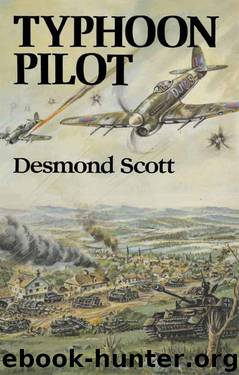Typhoon Pilot by Desmond Scott

Author:Desmond Scott [Scott, Desmond]
Language: eng
Format: epub
Publisher: Leo Cooper Ltd
Published: 1982-09-01T07:00:00+00:00
8
123 Wing, 2nd TAF
2nd Tactical Air Force was extremely fortunate in having 198 and 609 Squadrons to form the foundation for its 123 Wing. Both were outstanding low-attack squadrons and had good keen ‘press on’ types as their commanding officers. Both squadrons were engaged in a similar role to the one I had dictated to the Tangmere wing, so I was well versed in the daily activities of the flying side of my new appointment.
An auxiliary squadron, 609, had been formed at Yeadon, Yorkshire, during the winter of 1936, and was known as the West Riding Squadron. Its crest was typical of the county. Superimposed on a white rose were two crossed hunting horns, and on its scroll the motto ‘Tally Ho’. Strangely, none of its pilots were now from Yorkshire. The majority were Belgians—tough, likeable, keen, experienced, and a great credit to their homeland. The outstanding contribution they made to the success of 609 Squadron, though often sorely won, was always a splendid example to those who flew with them.
During the comparatively brief period since it had been equipped with Typhoons, 609 had lost 25 pilots, but it had destroyed 77 enemy aircraft and many light coastal craft and railway locomotives. The squadron’s previous commanding officer, Squadron Leader Pat Thornton-Brown, had been a particularly good friend not only to me but to many Typhoon pilots. While Pat and his boys had been escorting three boxes of American Marauders, he was attacked from behind by a swarm of American Thunderbolts. Recognition signals had been sent out, but the inexperienced Americans continued their attack, and shot down Pat and a Canadian pilot, ‘Chuck’ Miller. Both were killed.
198 was a much older squadron, recently rejuvenated. Formed in 1917 but disbanded shortly after the First World War it was not reformed again until December 1942. Like all Typhoon squadrons it suffered the usual teething troubles, but on shifting down from the north to 11 Group it quickly made a name for itself in low-level operations. The squadron’s crest bore the motto Igni Renatus (We are reborn by fire) and pictured a phoenix holding a sword in its beak. Its pilots were cosmopolitan and much to my delight included a spattering of New Zealanders, Australians and Canadians. A tremendous—though friendly—rivalry began at Manston between 609 and 198, a rivalry that was to continue in 123 Wing until the end of the war in Europe.
For the first few days I had little time to interest myself in anything other than my mobile airfield. The sight of so much transport almost frightened me. To be effective 123 Wing, as its name implied, had to get moving, and after a number of conferences with the section commanders, many of whom had served in the Desert Air Force, we soon became familiar with the rudiments, if not some of the arts, of successful mobile air warfare. Our first major exercise was to shift from Manston to Thorney Island, a large permanent aerodrome on a small isthmus midway between Chichester and Portsmouth, some 120 miles west along the south coast.
Download
This site does not store any files on its server. We only index and link to content provided by other sites. Please contact the content providers to delete copyright contents if any and email us, we'll remove relevant links or contents immediately.
| Africa | Americas |
| Arctic & Antarctica | Asia |
| Australia & Oceania | Europe |
| Middle East | Russia |
| United States | World |
| Ancient Civilizations | Military |
| Historical Study & Educational Resources |
Flight by Elephant(1483)
The Rise and Fall of the Third Reich: A History of Nazi Germany by William L. Shirer(1384)
Unbroken: A World War II Story of Survival, Resilience, and Redemption by Hillenbrand Laura(1102)
German submarine U-1105 'Black Panther' by Aaron Stephan Hamilton(1018)
Last Hope Island by Lynne Olson(937)
A Bridge Too Far by Cornelius Ryan(929)
The Victors - Eisenhower and His Boys The Men of World War II by Stephen E. Ambrose(904)
War by Unknown(904)
The Guns at Last Light: The War in Western Europe, 1944-1945 by Rick Atkinson(888)
Rogue Heroes: The History of the SAS, Britain's Secret Special Forces Unit That Sabotaged the Nazis and Changed the Nature of War by Ben Macintyre(884)
0060740124.(F4) by Robert W. Walker(872)
The Hitler Options: Alternate Decisions of World War II by Kenneth Macksey(865)
The Railway Man by Eric Lomax(847)
All the Gallant Men by Donald Stratton(815)
Hitler's Vikings by Jonathan Trigg(809)
A Tragedy of Democracy by Greg Robinson(801)
Churchill's Secret War by Madhusree Mukerjee(799)
Hitler's Armies by Chris McNab(782)
We Die Alone: A WWII Epic of Escape and Endurance by David Howarth & Stephen E. Ambrose(747)
